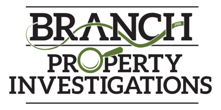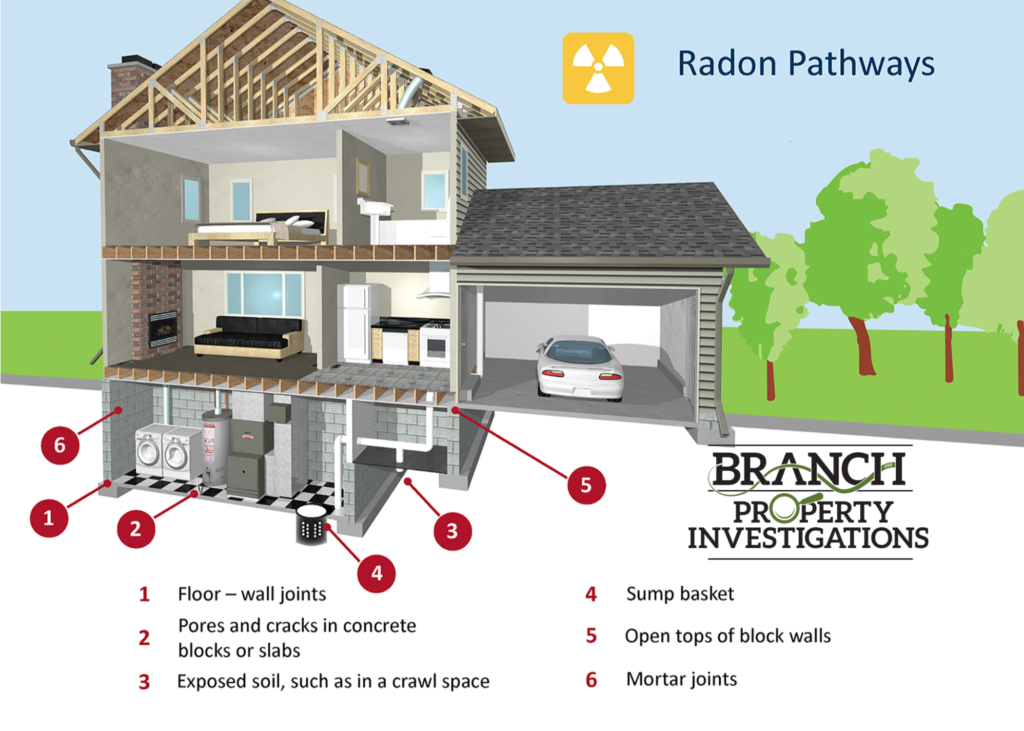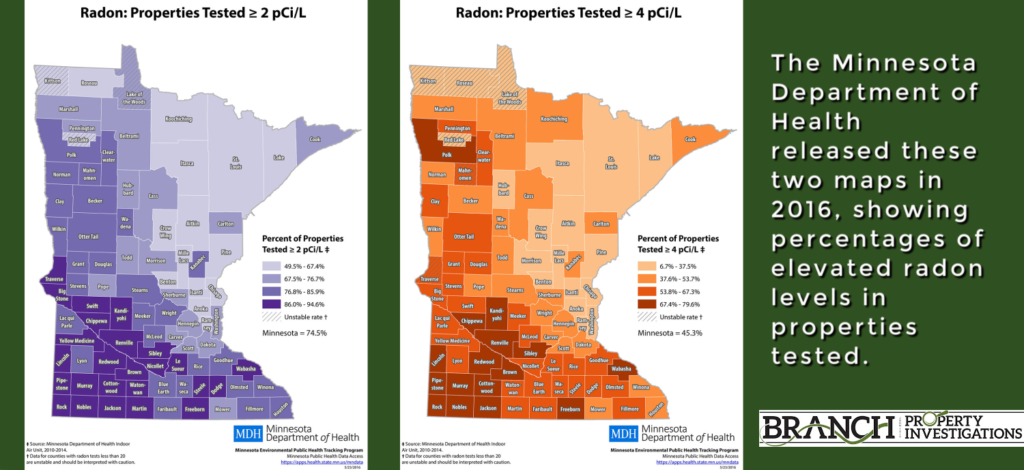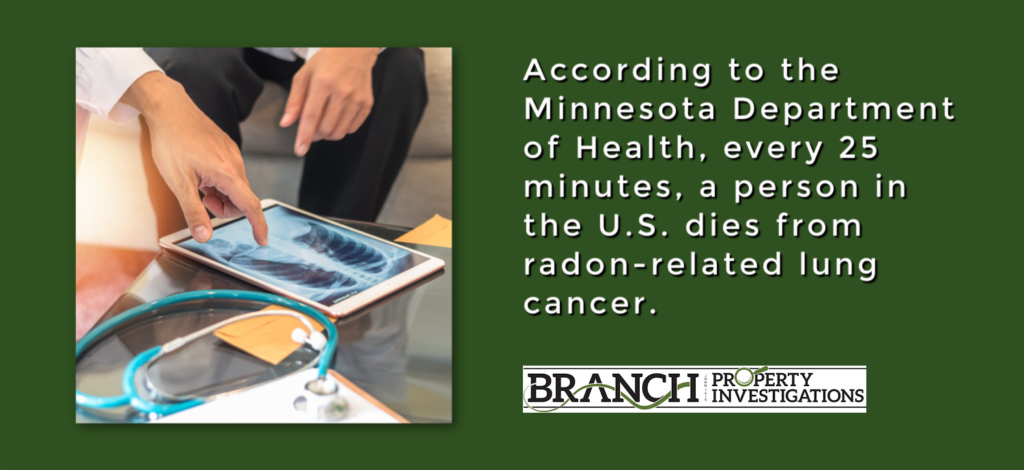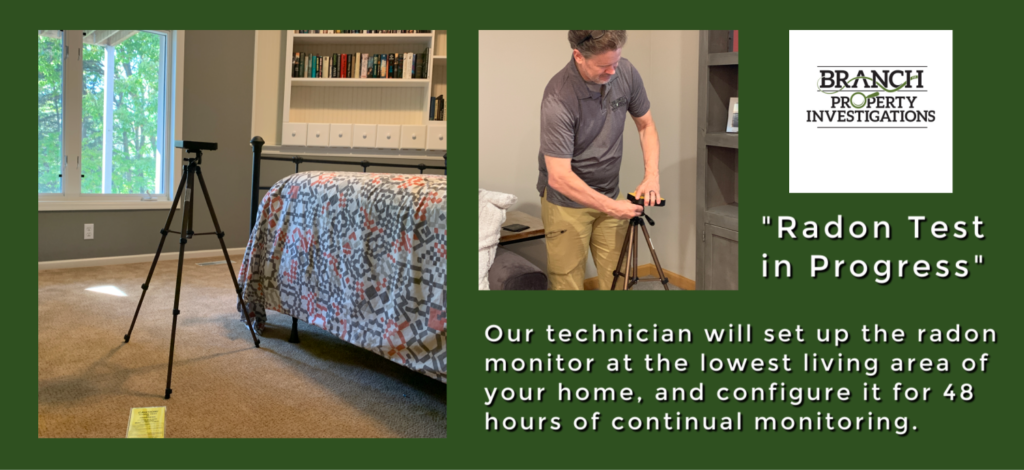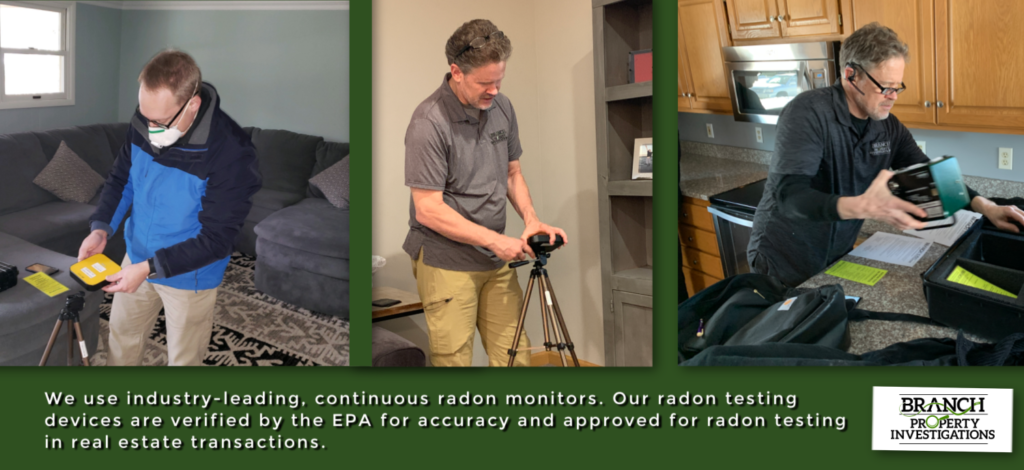We field a lot of questions about radon gas, so today we’ll cover the basics: what it is, where it’s found, its possible health effects, and what you can do to protect your home and family against radon in Minnesota.
Since radon gas has been identified as the second leading cause of lung cancer in the United States, prudent realtors and home buyers should learn if a home is contaminated prior to owning that house. Whether you’re new to a home or have been living there for years, testing is advisable to ensure your family is not exposed to dangerous radon levels.
What is Radon?
Radon is a radioactive gas. It is colorless, odorless, and tasteless. Radon is formed by the natural radioactive decay of uranium in rock, soil, and water. Low levels of uranium occur naturally in the ground.
Once produced, radon moves through the ground to the air above. Some radon remains below the surface and dissolves in the water table flowing underground.
How Does Radon Enter My Home?
Radon enters your home the same way air and other soil gases enter your home. Radon travels through cracks in the foundation floor or walls, hollow-brick walls, and openings around floor drains, pipes and sump pumps.
Unless you test for it, there is no way of telling how much radon is present.
Radon In Minnesota
Radon is a serious public health concern in Minnesota. According to the MN Department of Health, the average radon level in Minnesota is more than three times higher than the U.S. radon level!
This is due to our geology and how our homes are operated. Minnesota homes are closed up or heated most of the year, which can result in higher levels of radon. In Minnesota, more than two in five homes have radon levels that pose a significant health risk.
The lower half of Minnesota (including all of the Twin Cities and surrounding areas) has been identified by the EPA as the highest zone, Zone 3, for radon concentration. Because of this high radon concentration, there are a significant number of homes in our area that exceed the danger level of 4.0 pCi/L.
There’s no way to predict exactly where radon might show up, but you can check the EPA’s color-coded map to see predicted averages for every county in the continental United States.
Should Home Buyers Ask About Radon?
When you’re buying a house, we recommend you ask the sellers whether it’s been recently tested for radon (test results are valid within the past two years}. If it has, ask to see the results. If it hasn’t, it would be wise to have the home tested by a professional.
It is common for the buyer to perform a radon test alongside the home inspection. The results of the radon test can be a contingency of the purchase contract.
The EPA recommends that to improve indoor air quality, people should consider installing a mitigation system to reduce radon levels below 2.0. While 4.0 is the number that triggers seller action (usually), the lower the radon, the less cumulative impact on health.
Why Should I Test My Home for Radon?
The MN Department of Health recommends that all Minnesota homeowners test their homes for radon because it is widely believed to be the second leading cause of lung cancer.
A radon test is the only way to find out how much radon is in your home. Hiring a licensed radon measurement professional is recommended when an unbiased, third party is needed, such as in a real estate transaction. The result from a properly performed radon test will help you decide if you need to reduce your home’s radon level.
The MN Department of Health estimates that 2 in 5 homes exceed the 4.0 pCi/L action level.
My Neighbor’s Radon Level was Low, Why Should I Bother Testing?
Even if neighboring homes share similar soil and earth below, the homes themselves are constructed differently. It’s not uncommon for neighboring homes to have varying degrees of radon contamination.
During a recent investigation at a client’s property, we learned the house next door was owned by the client’s brother. The client’s brother had recently tested his home for radon and received a low result so he encouraged our client not to “waste his money on testing”. Our client opted to test anyway and we discovered radon levels exceeding the EPA action level of 4.0 pCi/L! Radon gas levels truly do vary house by house!
How Does Radon Cause Lung Cancer?
Radon causes cancer when the radon decay product is inhaled and becomes deeply lodged in the lungs. These particles radiate and can penetrate bronchial cells, mucous membranes, and other lung tissues.
The carcinogenesis process begins from ionizing radiation energy affecting the bronchial cells. Radon-related lung cancers are generally seen in the upper airways. However, radon increases the frequency of all types of lung cancer. Included cancers are: Adenocarcinoma, Small Cell Carcinoma, and Squamous Cell Carcinoma.
According to the Minnesota Department of Health, every 25 minutes, a person in the U.S. dies from radon-related lung cancer. It is the leading environmental cause of cancer deaths and the leading 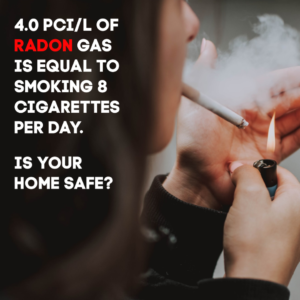 cause of lung cancer among non-smokers. Smoking tobacco multiplies the risk of radon-induced lung cancer by an average of 10 times.
cause of lung cancer among non-smokers. Smoking tobacco multiplies the risk of radon-induced lung cancer by an average of 10 times.
According to both the U.S. Environmental Protection Agency (EPA) and the National Academy of Sciences (NAS), long-term exposure to radon is directly responsible for approximately 21,000 lung cancer deaths per year. Many of these deaths are among people who have never smoked. But it’s also important to note that not everyone exposed to high levels of radon will get lung cancer during their lifetime.
What Can I Expect if I Hire Branch Property Investigations to Test for Radon in My Home?
When you schedule a test from Branch Property Investigations, one of our radon testing technicians will come to your home and identify the lowest living area in your house. For most homes in Minnesota, this is the basement.
Our technician will set up the radon monitor at the lowest living area of your home, and configure it for 48 hours of continual monitoring. The house must have closed-house conditions for 12 hours prior to starting the test–see below for more information. (If additional levels of a foundation system are discovered, extra radon unit(s) are required by the MN Department of Health and will need to be added for an additional fee.)
12 hours prior to the start of your test and during the two days of your test, you must avoid opening any windows. Ideally, you should not run your air conditioning system. Normal opening and closing of your entrance door is okay, but you should not leave it propped open. The radon monitor should not move for any reason. After two days, the technician will return and collect the tester. Then, we begin the process of analyzing the results. The test results and report are available to the client later that same day.
If a Radon Test Result is Less than 4 pCi/L, What Should be Done Next?
The EPA recommends to improve indoor air quality, people should consider installing a mitigation system reducing levels below 2.0. While 4.0 is the number that triggers seller action (usually), the lower the radon, the less cumulative impact on health.
Because radon levels can change over time, the MN Department of Health recommends retesting every 2-5 years. This is true especially if use patterns change or perhaps a lower level of the home becomes occupied. Renovations, changes in ventilation, or settling of ground beneath the home may cause indoor radon levels to change over time.
If a Radon Test Result is 4 pCi/L or Higher, What Should be Done Next?
The Environment Protection Agency claims in order for a home to qualify as safe, radon levels should not exceed 4 pCi/L. If your test results come back slightly elevated you may want to consider a follow-up test. This will confirm whether radon levels are high enough to warrant mitigation.
When the average of the initial test and the second test are equal to or greater than 4 pCi/L, the EPA recommends radon mitigation. If the average of the two test results are less than 4 pCi/L, consider testing again sometime in the future.
Additionally, radon levels can fluctuate between seasons or during varying weather conditions by a considerable amount. So, a retest following the initial test may be wise.
Radon Levels are High, It’s Time to Mitigate!
Sealing cracks in the walls and floors is a good start, but it’s usually not enough. The EPA recommends hiring a qualified radon mitigation contractor with the right technical skills and experience to effectively set up a radon mitigation system.
One of the most common and effective mitigation methods involves setting up a sub-slab depressurization (SSD) system. SSD technology uses a fan-powered exhaust to draw radon gas from the soil beneath the foundation and vent it outside. It needs to vent far enough away from windows and other openings so that it will not re-enter.
If you’re a visual learner, you may appreciate this helpful video on How Radon Mitigation Works produced by our friends at American Radon Mitigation.
We are happy to recommend trusted referrals to our clients, or the EPA’s website may be a helpful source to find qualified mitigators.
I Need to Test for Radon, Who Should I Hire?
The professionals at Branch Property Investigations use industry-leading, continuous radon monitors. Our radon testing devices are verified by the EPA for accuracy and approved for radon testing in real estate transactions.
Our monitors routinely provide a more accurate picture of radon levels than charcoal canister test kits. (You may have read about these; they are available at most hardware stores.) They also provide hour by hour variation to help show diurnal patterns. Additionally, we have our monitors calibrated on an annual basis to ensure their accuracy.
We don’t perform mitigation, so we have no conflict of interest. We service the greater metro Twin Cities area and would be happy to conduct your radon test! You can schedule online at branchinvestigations.com or call (612) 440-8466.
